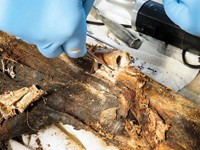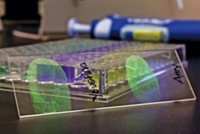Advertisement
Grab your lab coat. Let's get started
Welcome!
Welcome!
Create an account below to get 6 C&EN articles per month, receive newsletters and more - all free.
It seems this is your first time logging in online. Please enter the following information to continue.
As an ACS member you automatically get access to this site. All we need is few more details to create your reading experience.
Not you? Sign in with a different account.
Not you? Sign in with a different account.
ERROR 1
ERROR 1
ERROR 2
ERROR 2
ERROR 2
ERROR 2
ERROR 2
Password and Confirm password must match.
If you have an ACS member number, please enter it here so we can link this account to your membership. (optional)
ERROR 2
ACS values your privacy. By submitting your information, you are gaining access to C&EN and subscribing to our weekly newsletter. We use the information you provide to make your reading experience better, and we will never sell your data to third party members.
Analytical Chemistry
Could crime scene bloodstains reveal a person’s age and the time of the crime?
Forensic assay measures concentrations of a blood enzyme that varies with age
by Melissa Pandika
June 8, 2016

A new forensic method could allow law enforcement to determine whether blood at a crime scene came from a minor or an adult, and when the suspect or victim left it behind (Anal. Chem. 2016, DOI: 10.1021/acs.analchem.6b01169).
When DNA analysis doesn’t turn up a match for blood found at a crime scene, researchers turn to other methods to glean information about whoever left the blood behind. Problem is, existing methods for determining the age of the person or for measuring how long blood has been at a crime scene suffer from poor accuracy and have to be conducted in a lab.
Jan Halámek of the University at Albany, SUNY, set out to develop a fast, easy-to-use assay that could be adapted for use in the field to determine these attributes from blood. The assay could speed up investigations by narrowing the suspect list early on. Knowing whether the blood came from a minor or an adult could also affect the trial, prosecution, and sentencing.
Halámek and colleagues focused on alkaline phosphatase (ALP), an enzyme present in bones and blood. ALP levels peak during active bone growth—which occurs through adolescence and lasts slightly longer in males—before decreasing sharply around age 17 for females and 18 for males. Previous studies had measured ALP concentrations in healthy individuals and determined the standard ranges for females aged 0-17 and 18-60 and for males aged 0-18 and 19-60. To mimic human blood, the researchers spiked 100 samples of commercially bought human serum with randomly generated concentrations of ALP chosen to match natural enzyme levels found in each sex and age group.

To determine the ALP concentration of the samples, Halámek’s team used a known assay catalyzed by ALP: the conversion of p-nitrophenyl phosphate (pNPP) to p-nitrophenol, a yellow compound that can be measured using spectrophotometry. Higher ALP concentrations result in a faster conversion of pNPP to p-nitrophenol, producing a stronger color change after a given amount of time than low ALP levels. A statistical test on the measurements revealed that the assay had a 99% probability of differentiating young males from old, and a 100% probability of differentiating young from old females, even over time as the samples sat on a lab bench near a window for 48 hours to replicate crime scene conditions.
The researchers also used the data to develop a model that could predict how long blood has been at the crime scene. Since ALP activity drops over time, they could correlate p-nitrophenol levels in a subset of samples to the amount of time the samples had sat before measurement. The researchers saw about 90% agreement between the times predicted by the model versus the actual times. Even at 48 hours, p-nitrophenol measurements could still distinguish between young and old samples.
But the researchers didn’t use real human blood, in which other components could interfere with the ALP reaction, points out Mikhail Berezin of Washington University. ALP levels can vary due to factors other than age, such as bone disease and alcohol abuse, he says, so testing a suite of age biomarkers could address that concern. Plus, many crime scenes remain undiscovered until long after 48 hours. Despite the need for such technology, this method is “a very, very preliminary thing,” he says.
Halámek says that he and his team focused on healthy ALP levels to start. Later, they plan to include blood collected from a large sample of human subjects and develop a way to determine ages more specifically. They envision a test-strip-based assay similar to those used in glucometers—and methods that target sweat and fingerprints, too. For now, “it can be a preliminary method to narrow the pool of subjects so that the investigation is not delayed.”





Join the conversation
Contact the reporter
Submit a Letter to the Editor for publication
Engage with us on Twitter